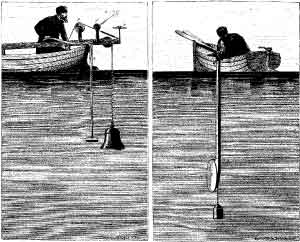The First Studies of Underwater Acoustics: The 1800s
The first successful measurements of the speed of sound in water were not made until the early 1800s. Using a long tube to listen underwater, as suggested by da Vinci, scientists in 1826 recorded how fast the sound of a submerged bell traveled across Lake Geneva.

In 1826 on Lake Geneva, Switzerland, Jean-Daniel Colladon, a physicist, and Charles-Francois Sturm, a mathematician, made the first recorded attempt to determine the speed of sound in water. In their experiment, the underwater bell was struck simultaneously with ignition of gunpowder on the first boat. The sound of the bell and flash from the gunpowder were observed 10 miles away on the second boat. The time between the gunpowder flash and the sound reaching the second boat was used to calculate the speed of sound in water. Colladon and Sturm were able to determine the speed of sound in water fairly accurately with this method. J. D. Colladon, Souvenirs et Memoires, Albert-Schuchardt, Geneva, 1893.
Colladon and Sturm measured the water temperature in the lake to be 8° centigrade. At this temperature, they determined the speed of sound in fresh water to be 1435 meters per second, which differs from the currently accepted value by only 3 meters per second. Their published results also reported earlier measurements in sea water made in 1820 near Marseilles by François Sulpice Beudant, a French physicist. Beudant’s measurements averaged about 1500 meters per second, approximate results expected for sea water.
At about this same time, scientists began to think about the practical applications of underwater sound. One of the first applications that scientists explored was to determine the depth of the sea by listening for echos. At the time, water depth was measured by lowering a weighted line from the deck of a ship, which is tedious, dangerous, and not very accurate.
In 1838, Charles Bonnycastle performed the first known echo sounding experiments. In 1859, Lt. Matthew Fontaine Maury, commander of the U.S. Navy Depot of Charts and Instruments, attempted, unsuccessfully, to use sound to measure the depth of the ocean. These experiments failed not because the idea was wrong, but because Lt. Maury did not use an underwater receiver to listen for the echo. Eventually, echo sounding became one of the most important applications of underwater sound.
In 1877 and 1878, the British scientist John William Strut, also known as Lord Rayleigh, published The Theory of Sound, a two-volume work often regarded as marking the beginning of the modern study of acoustics. Lord Rayleigh was the first to formulate the wave equation, a mathematical means of describing sound waves that is the basis for all work on acoustics. His work set the stage for the development of the science and application of underwater acoustics in the twentieth century.
Additional Links on DOSITS
Additional Resources
- NOAA Office of Coast Survey: History of Hydrographic Surveying